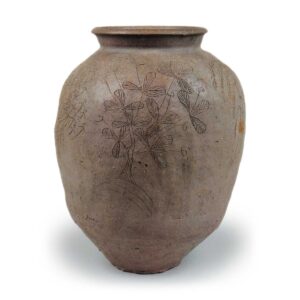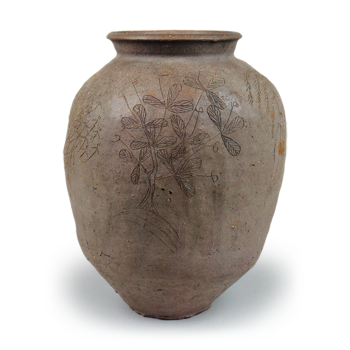
Excavated from Kinzo, Machino-cho, Wajima City, Ishikawa Prefecture
13th century
Height 39.2cm, Bowl diameter 17.3cm, Body diameter 30.9cm, Bottom diameter 11.5cm
Important Cultural Property
This is a medium-sized jar with a stroked shoulder and a short, slightly outward-curving neck with a thickened tip. It is a typical medium-sized jar of the late 13th century. The design is divided into four sections, each of which has different paintings on the four sides. On one side, a diagonal lattice pattern is painted using the comb technique, which was widely used during this period. The other three sides are painted with four tree motifs, while the fourth side has two tree motifs side by side. The tree patterns are arranged from left to right. Both trees are made of thin metal-like almsgiving tools.
The one on the far left depicts a wisteria hanging from a pine tree, while the one on the right depicts a branch extending from the trunk of a tree with three clearly veined leaves at the tip of each branch. It is thought to be a karatachi. Of the two trees depicted side by side on the next panel, the one on the left shows branches hanging down from the trunk in thin line engravings, while the one on the right shows a broken branch that appears to be the same species as the one on the left. It is clear that the wisteria on the pine tree in the Yamato-e paintings popular at the time represents spring and the karatachi represents summer, while the tree with the fallen leaves and broken branches indicates autumn and winter.
The carved images depict seasonal scenes throughout the painting, which is a remnant of the painting techniques of the imperial court.



